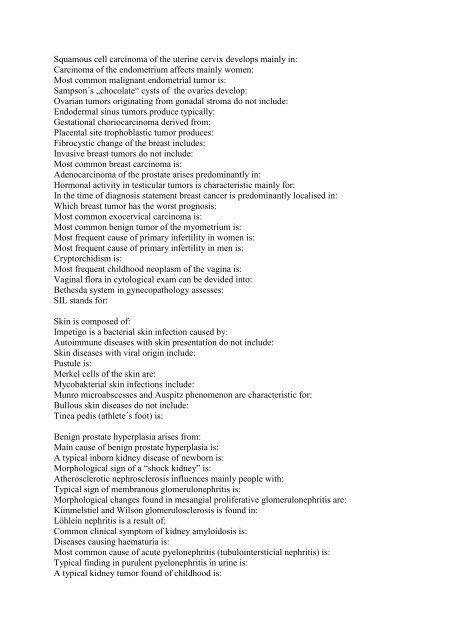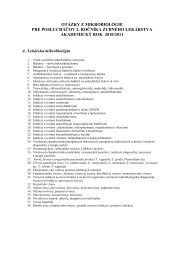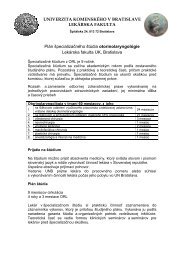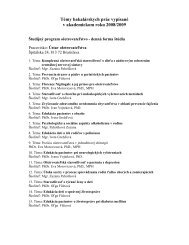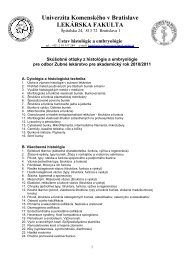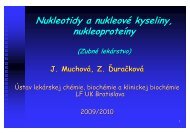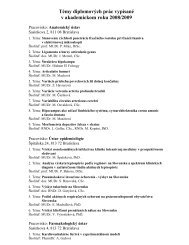Questions for the written exam in pathological anatomy
Questions for the written exam in pathological anatomy
Questions for the written exam in pathological anatomy
You also want an ePaper? Increase the reach of your titles
YUMPU automatically turns print PDFs into web optimized ePapers that Google loves.
Squamous cell carc<strong>in</strong>oma of <strong>the</strong> uter<strong>in</strong>e cervix develops ma<strong>in</strong>ly <strong>in</strong>:Carc<strong>in</strong>oma of <strong>the</strong> endometrium affects ma<strong>in</strong>ly women:Most common malignant endometrial tumor is:Sampson´s „chocolate“ cysts of <strong>the</strong> ovaries develop:Ovarian tumors orig<strong>in</strong>at<strong>in</strong>g from gonadal stroma do not <strong>in</strong>clude:Endodermal s<strong>in</strong>us tumors produce typically:Gestational choriocarc<strong>in</strong>oma derived from:Placental site trophoblastic tumor produces:Fibrocystic change of <strong>the</strong> breast <strong>in</strong>cludes:Invasive breast tumors do not <strong>in</strong>clude:Most common breast carc<strong>in</strong>oma is:Adenocarc<strong>in</strong>oma of <strong>the</strong> prostate arises predom<strong>in</strong>antly <strong>in</strong>:Hormonal activity <strong>in</strong> testicular tumors is characteristic ma<strong>in</strong>ly <strong>for</strong>:In <strong>the</strong> time of diagnosis statement breast cancer is predom<strong>in</strong>antly localised <strong>in</strong>:Which breast tumor has <strong>the</strong> worst prognosis:Most common exocervical carc<strong>in</strong>oma is:Most common benign tumor of <strong>the</strong> myometrium is:Most frequent cause of primary <strong>in</strong>fertility <strong>in</strong> women is:Most frequent cause of primary <strong>in</strong>fertility <strong>in</strong> men is:Cryptorchidism is:Most frequent childhood neoplasm of <strong>the</strong> vag<strong>in</strong>a is:Vag<strong>in</strong>al flora <strong>in</strong> cytological <strong>exam</strong> can be devided <strong>in</strong>to:Be<strong>the</strong>sda system <strong>in</strong> gynecopathology assesses:SIL stands <strong>for</strong>:Sk<strong>in</strong> is composed of:Impetigo is a bacterial sk<strong>in</strong> <strong>in</strong>fection caused by:Autoimmune diseases with sk<strong>in</strong> presentation do not <strong>in</strong>clude:Sk<strong>in</strong> diseases with viral orig<strong>in</strong> <strong>in</strong>clude:Pustule is:Merkel cells of <strong>the</strong> sk<strong>in</strong> are:Mycobakterial sk<strong>in</strong> <strong>in</strong>fections <strong>in</strong>clude:Munro microabscesses and Auspitz phenomenon are characteristic <strong>for</strong>:Bullous sk<strong>in</strong> diseases do not <strong>in</strong>clude:T<strong>in</strong>ea pedis (athlete´s foot) is:Benign prostate hyperplasia arises from:Ma<strong>in</strong> cause of benign prostate hyperplasia is:A typical <strong>in</strong>born kidney disease of newborn is:Morphological sign of a “shock kidney” is:A<strong>the</strong>rosclerotic nephrosclerosis <strong>in</strong>fluences ma<strong>in</strong>ly people with:Typical sign of membranous glomerulonephritis is:Morphological changes found <strong>in</strong> mesangial proliferative glomerulonephritis are:Kimmelstiel and Wilson glomerulosclerosis is found <strong>in</strong>:Löhle<strong>in</strong> nephritis is a result of:Common cl<strong>in</strong>ical symptom of kidney amyloidosis is:Diseases caus<strong>in</strong>g haematuria is:Most common cause of acute pyelonephritis (tubulo<strong>in</strong>tersticial nephritis) is:Typical f<strong>in</strong>d<strong>in</strong>g <strong>in</strong> purulent pyelonephritis <strong>in</strong> ur<strong>in</strong>e is:A typical kidney tumor found of childhood is:


